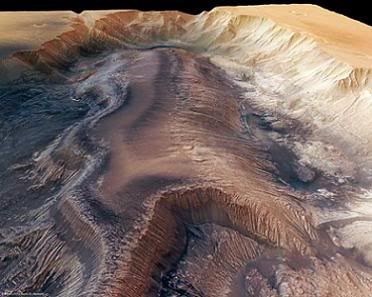Post by glactus on Sept 30, 2011 1:07:34 GMT

The Valles Marineris rift system
Valles Marineris (named after the Mariner 9 Mars orbiter of 1971- 72 which discovered it) is a system that runs along the Martian surface east of the Tharsis region. At more than 4,000 km long, 200 km wide and up to 7 km deep, the Valles Marineris rift system is the largest known canyon, surpassing all surface canyons on Earth. Valles Marineris is located along the equator of Mars, on the east side of the Tharsis Bulge, and stretches for nearly a quarter of the planet's circumference.

Valles Marineris. A place of vastness and solitude
Hebes Chasma is a completely closed depression in the surface of Mars, with no outflows to the nearby Echus Chasma to the west, Perrotin Crater to the southwest, or Valles Marineris to the south. Its maximum extents are approximately 320 km east to west, 130 km north to south, and 5 to 6 km in depth. At the center of the depression is a large mesa rising some 5 km off the valley floor, nearly as high as the surrounding terrain. This central plateau makes Hebes Chasma a unique valley in Martian geography.

Hebes Chasma. What scenic marvels await us?
Echus Chasma is a chasma in the Lunae Planum high plateau north of the Valles Marineris canyon system of Mars. Clay has been found in Echus Chasma that means that water once sat there for a time. The Chasma is approximetely 100 km long and 10 km wide with valleys ranging in depth from 1 km to 4 km.

Echus Chasma.
Credits: These are non copywrite images
Text by Wikipedia


